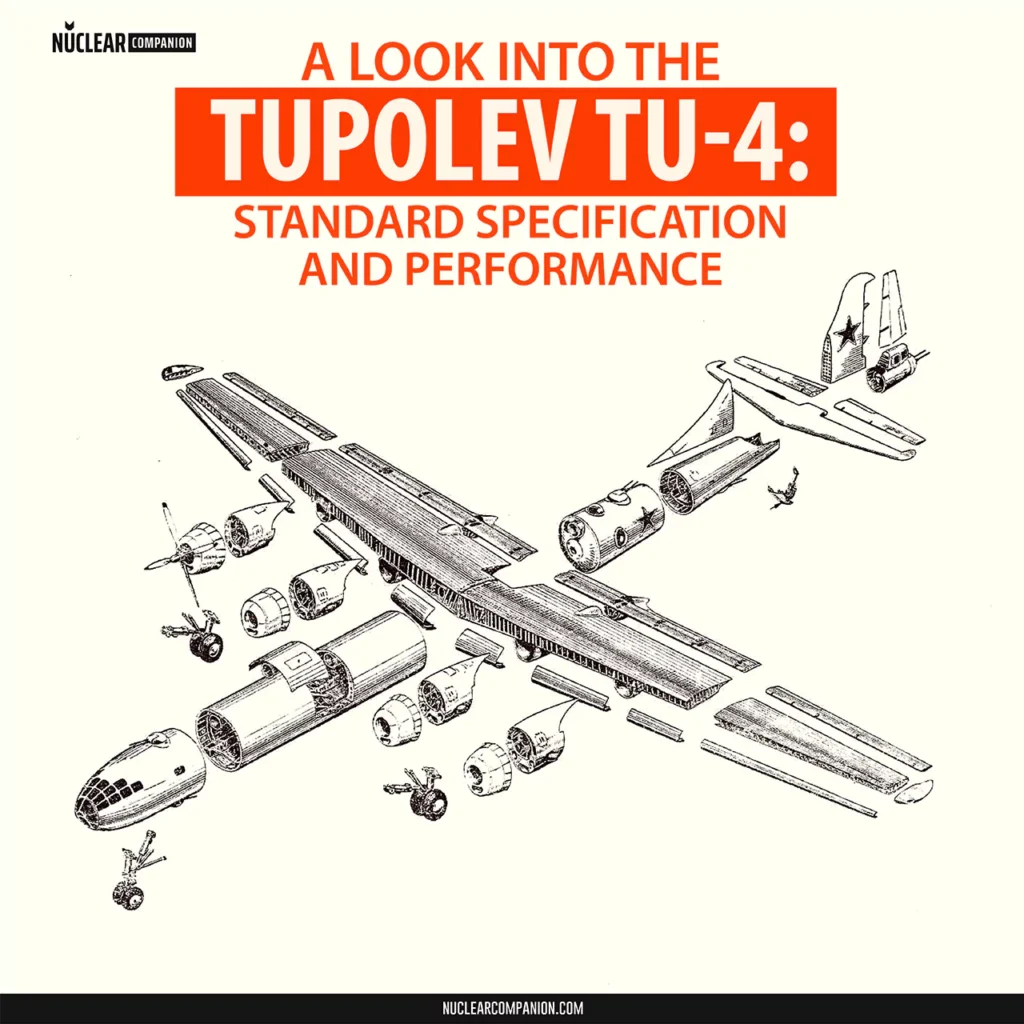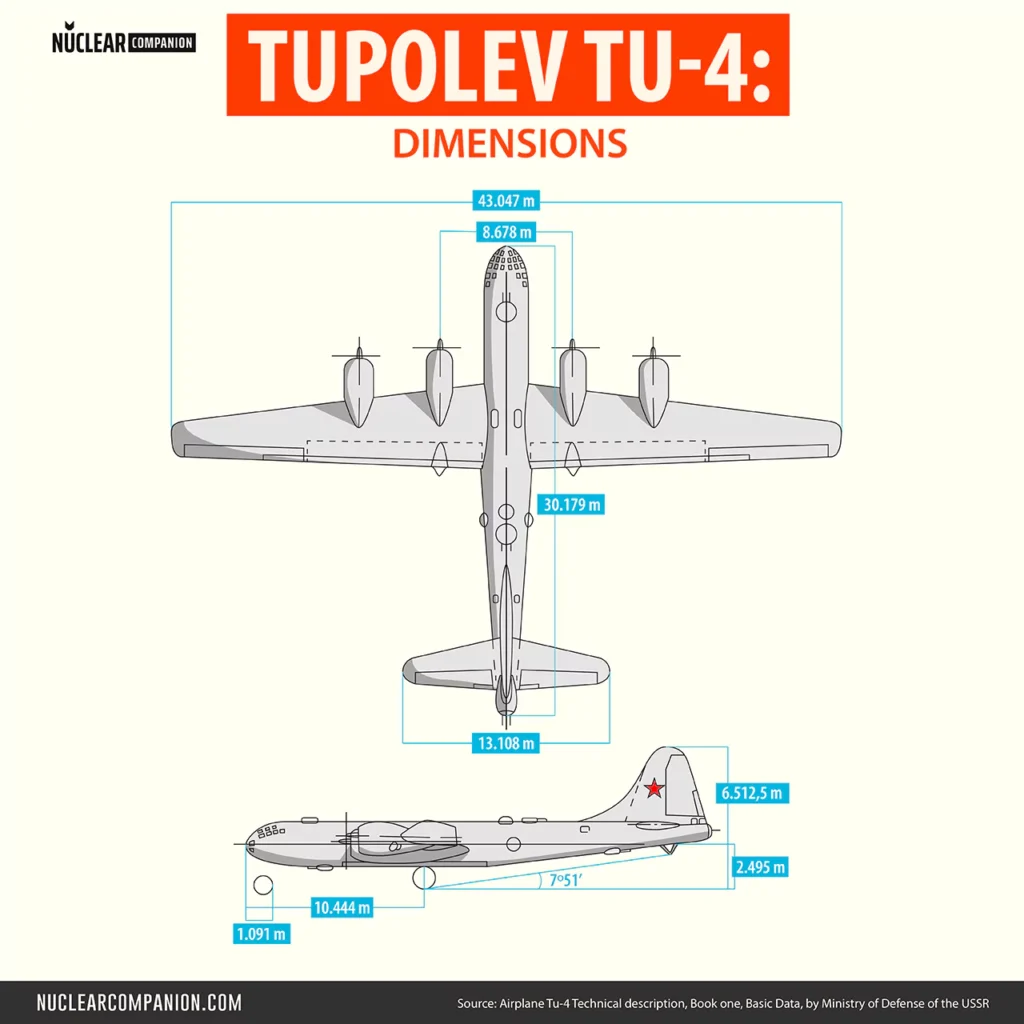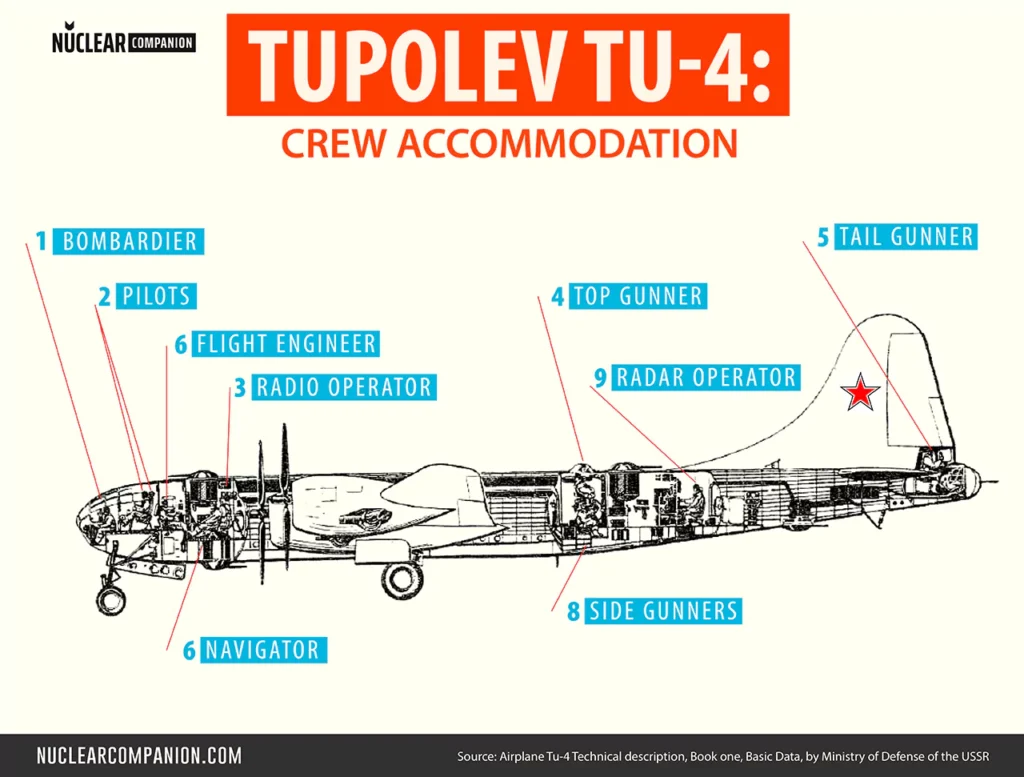
The Tupolev Tu-4 was a strategic bomber utilized by the Soviet Air Force during the late 1940s to mid-1960s. This aircraft, powered by piston engines, was a replica of the famed Boeing B-29 Superfortress. It was the OKB-156 design bureau, led by Andrei Tupolev, that was given the task of reverse engineering the B-29.
But, the Tu-4 (izdeliye R) was not an exact copy of the B-29, as it was fitted with different engines (the indigenous ASH-73TK) and had a heavier defensive armament.
The Tupolev Tu-4 bomber was produced by three factories in a standard long-range version. It was designed for delivering large bomb strikes against strategic targets located deep within enemy territory regardless of the time of day or weather conditions.

The following description and basic performance applies to the standard production Tu-4:
Dimensions

| Parameter | Value |
|---|---|
| Length overall (less cannon barrels ) | 30.177m (99ft 0%in ) |
| Wing span | 43.047m (141ft 2%in ) |
| Horizontal tail span | 13.108m (43ft 0%in ) |
| Height on ground | 8.46m (27ft 9%in .) |
| Landing gear track | 8.676m (28 ft 5in ) |
| Landing gear wheelbase | 10.444 m (34 ft 3 in) |
| Ground angle | 2° |
| Maximum rotation angle | 9°30' |
| Root chord | 5.18 m (16 ft 11% in) |
| Tip chord | 2.25 m (7 A 4°% in) |
| Mean aerodynamic chord (MAC) | 4.001 m (13 ft 1% in) |
| Wing area | 116,17 m2 (1,250.44 sq ft) |
| Aileron area (total) | 12.01 m2 (129.27 sq ft) |
| Flap area (total) | 30.79 m2 (331,42 sq ft) |
| Vertical tail area | 22.01 m2 (236.91 sq ft) |
| Fin area (including root fillet) | 15.94 m2 (171.58 sq ft) |
| Rudder area | 6.1 m2 (65.66 sq ft) |
| Horizontal tail area | 30.94 m2 (333.04 sq ft) |
| Stabiliser area | 20.251 m2 (217.75 sq ft) |
| Elevator area (total) | 10.683 m2 (114.87 sq ft) |
Weights
| Airframe weight | 15,196 kg (33,501 lb) |
| Powerplant weight | 14,270 kg (31,470 lb) |
| Weapons systems weight : | |
| 407kg (897lb ) | |
| 1,890kg (4,166lb ) | |
| Operating empty weight | 35,270kg (77,760lb ) |
| Take-off weight : | |
| 47,500-47,600kg (104,720-104,940lb ) | |
| 54,500;60,900;61,500;65,000; | |
| 66,000kg (120,150;134,260; | |
| Landing weight : | 135,580;143,300;145,500lb )* |
| 48,000kg (105,820lb ) | |
| 60,000kg (132,280lb ) | |
| Payload, normal : | 12,330kg (27,180lb ) |
| 990kg (2,180lb ) | |
| 1,060kg (2,340lb ) | |
| 3,480kg (7,670lb ) | |
| 800kg (1,760lb ) | |
| 6,000kg (13,230lb ) | |
| Payload, high gross weight configuration : | 19,230kg (42,390lb ) |
| 990kg (2,180lb ) | |
| 1,060kg (2,340lb ) | |
| 8,150kg (17,970lb ) | |
| 1,030kg (2,270lb ) | |
| 8,000kg (17,640lb )(eight FAB -1000bombs ) |
Power Plant
- Engine Model: ASh-73TK 18-cylinder radial engine.(For details on the ASh-73KT, you can read here)
- Engine Manufacturer: OKB-19 NKAP, MAP also known as Perm Motor-Building Design Bureau (PMKB) named after. P.A. Solovyov
- Propeller Manufacturer: OKB-120 MAP, GKAT at plant No. 120 also known as Stupino Design Bureau of Mechanical Engineering (SKBM)
- Blade model designation: V3-A3, V3B-A5(Late-production)
- No. Blades: 4
- Propeller diameter: 5.056 m (16 ft 7 in)
Crew

Electronics
Navigation
The Radar RPB RPB Kobal’t or Kobal’t-M was used for navigation over the ground and target recognition. This was a copy of the US AN/APQ-13 re-engineered by NII-17.
An AP-5 autopilot was installed to reduce the burden on the pilots. This was a copy of the American S-1 autopilot. Copied by OKB-214 and produced by plant No.118
The Tu-4 was equipped with the SP-48 Instrument Landing System (ILS) that included:
| Equipment | Soviet designation | Comment |
|---|---|---|
| Automatic direction finder (ADF) | ARK-4 or ARK-5 Amur. | By OKB-528, produced in Plant No.798 |
| Low Range Radio altimeter | RV-2 "Lithium" (SCR-718) low-range radio altimeter (0-1,200 m/3,940 ft). | Copy of AN/PN-1 by NII-17 |
| High Range Radio altimeter | RV-10 high-range radio altimeter (100-15,000 m/330-49,210 ft). | Copy of SCR-718 |
| Marker Beacon transmitter | MRM-45 | |
| Marker Beacon Receiver | MRP-45 |
Tu-4s from c/ns 225501 and 230101 onwards, as well as c/ns 184232 and 184133, featured the SP-50 Materik Instrument Landing System (ILS) that consisted of the following components:
| Equipment | Soviet designation |
|---|---|
| Distance Measuring Equipment (DME) | SD-1 |
| Localiser (koorsovoy rahdio-priyomnik) | KRM |
| Localiser receiver | KRP-F |
| Glideslope beacon transmitter | GRM-2 |
| Glideslope beacon receiver | GRP-2 |
| Navigation computer | K-46B |
| Astrocompass | AK-53P |
| Marker Beacon transmitter | MRM-48 |
| Marker Beacon receiver | MRP-48 Dyatel (Woodpeacker) |
Communication
| Equipment | Soviet designation | Comment |
|---|---|---|
| Liaison Radio Set | RSB-70 "Berkut" (AN/ART-13) | Copy of AN/ART-13, produced by plant No. 197 |
| Command Radio Set | SCR-274H | Aircraft up to No. 222101 (Early production aircrafts) |
| Command Radio Set | 12RSU-10 Koora | On aircraft up to No. 221901, before the installation of RSU-5, |
| Command Radio Set | RSIU-3 | On aircraft with No. 221901 |
| Command Radio Set | RSU-5 | On aircraft after No. 221901 |
| Interphone | SPU-14 or SPU-14M on later aircraft. | |
| IFF Interrogator | Magniy ("Magnesium") (SCR-729) or Magniy-M | Copy of SCR-729 by NII-17. On aircraft up to No. 224501 Magniy, later, Magniy-M |
| IFF Transponder | Bariy ("Barium") (SCR-695) or Bariy-M | Copy of SCR-695 by NII-17 |
Armament
Defensive
The first three built Tu-4:
- PV-20 central fire control system
- 8 x 12.7-mm (.30 calibre) Berezin UBK machine-guns in four remote controlled turrets
- Tail turret with 3 x 12.7-mm (.30 calibre) Berezin UBK machine-guns
From the fourth aircraft (c/n 220102):
- PV-20 central fire control system
- 8 x 20-mm (.78 calibre) Berezin B-20E cannon in four remote controlled turrets
- Tail turret with 2 x 20-mm (.78 calibre) Berezin B-20E cannon
From c/ns 223201, 184309 and 230102 onwards:
- PV-23 “Zvezda” central fire control system
- 8 x 23-mm (.90 calibre) NR-23 cannon in four remote controlled turrets
- DK-3 tail barbette with 2 x 23-mm (.90 calibre) NR-23 cannon
Offensive
The Tupolev Tu-4 was fitted with a mixed complement of bomb racks, including the KD4-546A and KD4-546A. However, from Kazan’-built Tu-4 c/n 225701 onwards, a standardized set of bomb racks was introduced, enabling the aircraft to carry FAB-250M46 and FAB-500M46 bombs on two rows of shackles. This doubled the number of 250- and 500-kg bombs that the Tu-4 could carry.
Tu-4’s standardized set of bomb racks had four KD4-248 airborne cluster holders for FAB-1500 and FAB-3000 bombs, as well as eight KDZ-547 airborne cluster holders and four SDZ-248 twin holders. The KDZ-547 bomb racks had six stations and were designed to hold FAB-50, FAB-100, FAB-250, and FAB-500 bombs. The SDZ-248 twin holders had two stations that could be loaded with the same bombs as the KDZ-547 holders, but the FAB-500 bombs could only be suspended on the right station.
The Tu-4 also featured two BD5-50 beam holders, one in each compartment, for hanging FAB-5000 and BRAB-6000 bombs. These bombs were lifted using a BL-47 winch, with the FAB-50, FAB-100, and FAB-250 bombs being lifted by one winch using the PK-Der3-80 lifting hook. The FAB-500 bombs were lifted using the same lifting hook, but with two winches. The FAB-1500 and FAB-3000 bombs were lifted by the BL-47 winch using two types of lifting belts.
Bomb dropping is electric.
Possible Tu-4 payload options:
| Payload | Rack type | Bomb type (conventional) | Quantity of bombs (forward bay/aft bay) | Warload kg (lb) |
|---|---|---|---|---|
| a) mixed set of bomb racks | ||||
| Option 1 | KD4-546A | FAB-250M43 | 24 (12/12) | 6,000 (13,230) |
| KD3-246A | ||||
| Option 2 | KD4-546A | FAB-250M46 | 24 (12/12) | 6,000 (13,230) |
| KD3-246A | ||||
| Option 3 | KD4-546A | FAB-500M43 | 12 (6/6) | 5,830 (12,850) |
| Option 4 | KD4-546A | FAB-500M44 | 12 (6/6) | 6,000 (13,230) |
| FAB-500M46 | ||||
| Option 5 | KD4-546A | FAB-1000M44* | 8 (4/4) | 7,120 (15,700) |
| Option 6 | KD4-248 | FAB-1000M44* | 8 (4/4) | 7,120 (15,700) |
| Option 7 | KD4-248 | FAB-1500M44 | 8 (4/4) | 11,840 (26,100) |
| Option 8 | KD4-248 | FAB-3000M44 | 4 (2/2) | 11,930 (26,300) |
| b) standard set of bomb racks + | ||||
| Option 1 | KD4-547 | FAB-50 | 48 (20/20+4/4) | 2,000 (4,410) |
| SD3-248 | ||||
| Option 2 | KD3-547 | FAB-100 | 48 (20/20 + 4/4) | 5,900 (13,010) |
| SD3-248 | ||||
| Option 3 | KD3-547 | FAB-250M46 | 48 (20/20+4/4) | 10,600 (23,370) |
| SD3-248 | ||||
| Option 4 | KD4-547 | FAB-500M46 | 28 (12/12 + 4/4) | 12,000 (26,455) |
| SD3-248 | ||||
| Option 5 | KD4-547 | FAB-250M43 or | 24 (10/10+2/2) | 6,000 (13,230) |
| SD3-248 | FAB-250M44 | |||
| Option 6 | KD4-547 | FAB-500M43 or | 14 (6/6 + 1/1) | 6,800 (14,990) |
| SD3-248 | FAB-500M44 | |||
| Option 7 | KD4-248 | FAB-1000M44 | 8 (4/4) | 7,120 (15,700) |
| Option 8 | KD4-248 | FAB-1500M46 | 8 (4/4) | 11,840 (26,100) |
| Option 9 | KD4-248 | FAB-3000M46 | 4 (2/2) | 11,930 (26,300) |
| Option 10 | BD5-50 | FAB-6000M46 | 4 (2/2) | 11,930 (26,300) |
| Option 11 | FAB-250M44 | 24 (12/12) | 6,000 (13,230) | |
| Option 12 | FAB-500M44 | 14 (7/7) | 6,802 (14,995) | |
| Option 13 | FAB-1000M44 | 8 (4/4) | 7,120 (15,700) | |
Performance
| CG range | 25.7-30.1%MAC |
| Maximum speed : | |
| 420km /h (261mph ) | |
| 558-578km /h (346-359mph ) | |
| Landing speed | 172km /h (106mph ) |
| Rate of climb : | |
| 4.6m /sec (905ft /min ) | |
| 4.6m /sec | |
| 4.6m /sec | |
| 4.6m /sec | |
| 4.5m /sec (885ft /min ) | |
| 4.5m /sec | |
| 4.4m /sec (866ft /min ) | |
| 4.1m /sec (807ft /min ) | |
| 3.7m /sec (728ft /min ) | |
| 3.1m /sec (610ft /min ) | |
| 2.0 m/sec (393 f/min) | |
| 0.8 m/sec (157 ft min) | |
| 0.5 m/sec (98 ft/min) | |
| Time to height | |
| 3.6minutes | |
| 7.2minutes | |
| 10.9minutes | |
| 14.5minutes | |
| 18.2minutes | |
| 22.0minutes | |
| 25.9minutes | |
| 30.1minutes | |
| 35.1minutes | |
| 41.6minutes | |
| 53.3minutes | |
| 58.0minutes | |
| Service ceiling | 11,200-12,000m (36,745-39,370ft ) |
| Climb time to 5,000m (16,400ft ) | 18.2minutes |
| Maximum range | 5,600km (3,479miles ) |
| Range with maximum payload | 5,000km (3,105miles ) |
| Take -off run | 960-2,210m (3,150-7,250ft )† |
| Landing run | 1070-1750m (3,510-5,740ft )† |
| G limit : | |
| 4.6 | |
| 4.05 | |
| 3.56 |
Further reading
- Boeing B-29 Superfortress Facts: 11 things to know
- Basic performance of a typical late-production Tupolev Tu-4
- Shvetsov ASh-73 Engine
Source
- Tupolev Tu-4: The First Soviet Strategic Bomber by Yefim Gordon and Dmitriy Komissarov
- Airplane Tu-4 Technical description, Book one, Basic Data, by Ministry of Defense of the USSR, State Publishing House of the Defense Industry, Moscow 1953